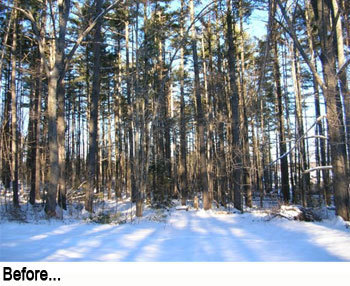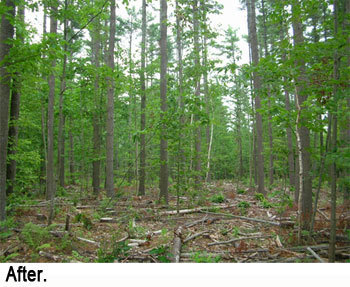 During
a panel discussion at the recent Local Wood Works conference in Augusta, a
consulting forester posed this question to the woodland owners in the room:
“What is the most important information that I as a forester can give you about
your woodlot?” To which the ready reply was, “Tell me what it’s going to look
like!” Data about basal area and estimates of growth and yields are all very
useful, of course, but what most woodland owners care most about are not silvicultural
statistics. What will their woods look like right after a timber harvest or
road construction job is over, or in five or ten years?
Obviously
it can be hard to predict the future, and even harder to show a picture of that
future forest condition. One tool that can help is called Picture Post. Picture Post is a
web site maintained by the University of New Hampshire that allows anyone to
upload a series of digital pictures taken from a single place in 9 different
directions. Place the camera on a small platform mounted on a 4x4 post, and
point and shoot to the 4 cardinal directions and one in between each of those
(North, Northeast, East, etc.) The ninth direction is facing straight up. The 8
horizontal shots provide a panoramic 360 degree view of the surrounding woods;
the upward looking shot shows tree crowns and canopy conditions. The website
has information about purchasing a top plate or building your own. It doesn’t
have to be fancy or expensive, just durable enough to remain in the woods for
an extended period of time.
|
 Ideally a series of pictures taken before harvesting or road construction activities will set the scene. Returning to the same place periodically can illustrate changes in the woods that might otherwise be too subtle to notice: advancing regeneration or invasive plants, crowns growing out to close the canopy; slow decline from insect or disease agents. The effect probably will be the most dramatic after the job is done, followed by continued gradual change. Of course the post itself needs care and protection during the operation-- or replacement afterwards!
 Since
a picture is worth 1,000 words, this type of long term monitoring can speak
volumes, and help your family members and other woodland owners envision what
the woods will look like in the future.
As always, you can call the Maine
Forest Service for more information or assistance at (800) 367-0223 (in state) or (207)
287-2791, or e-mail forestinfo@maine.gov.
|
|